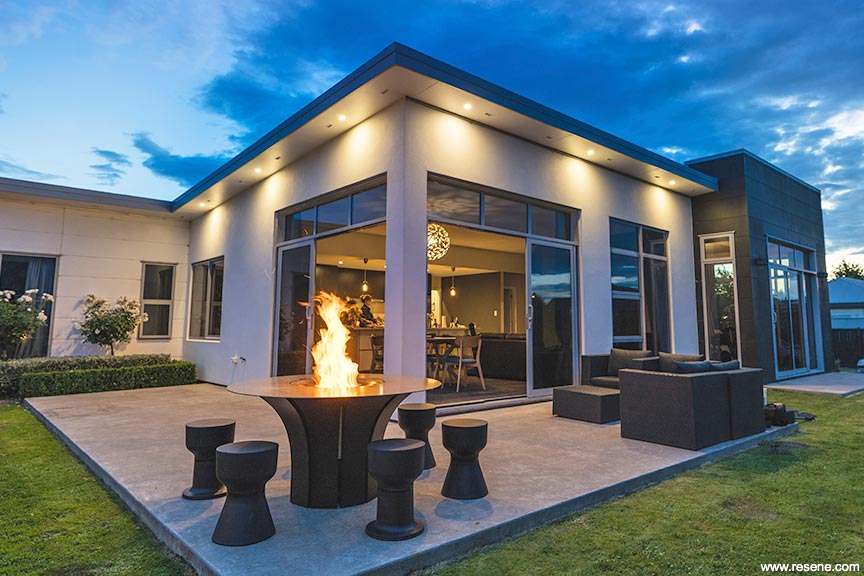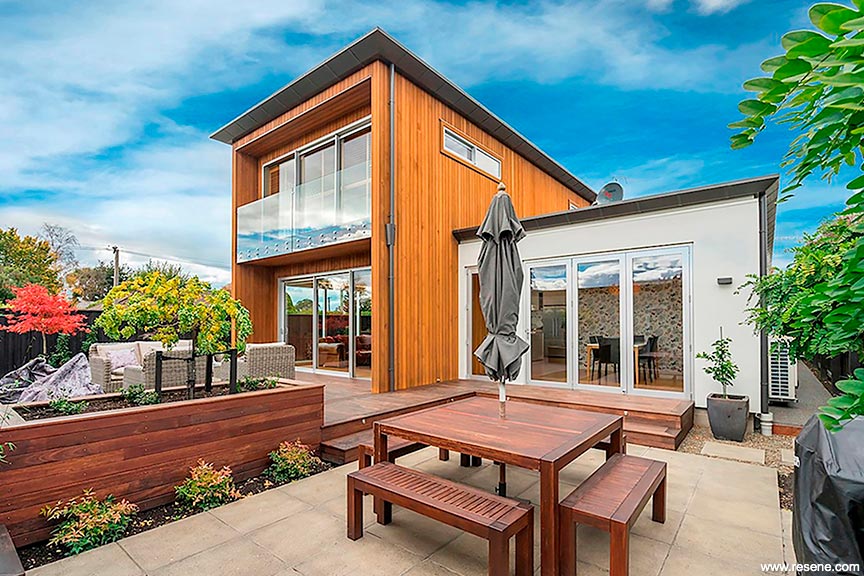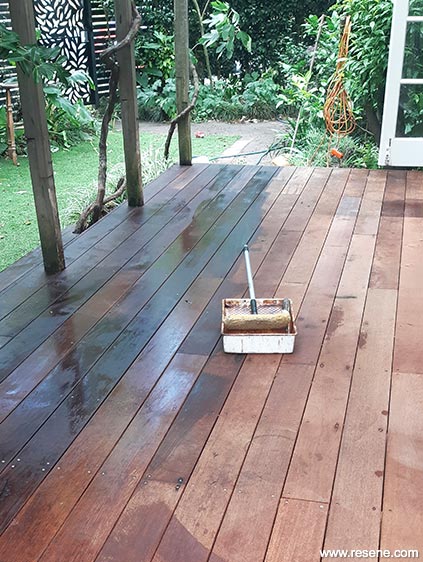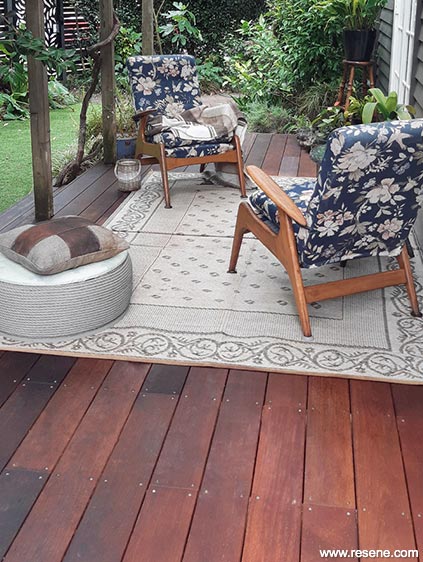From Habitat magazine - issue 32, maintenance feature
Winter is coming. Is your backyard ready?
The end of spring marks the beginning of a trying time for homeowners. Thanks to our favourable climate, many of us don't have to worry about the ground freezing or snow falling, but that doesn't mean there aren't plenty of things to do around the backyard to get ready before the mercury begins to drop.
In some way or another, nearly every element that you have in your backyard can (and should) be winterised in order to protect your investments, right from your lawn furniture and grills to your swimming pool and garden accessories. Plus, there are plenty of projects you can do to help make your patio an enjoyable place to spend time year-round.
When you properly winterise your backyard, it can save you a lot of time and energy when spring comes around again. Try these ideas to preserve and maintain your backyard during the winter season.

Top tip: The bright sun tends to make exterior colours look lighter, so make sure your exterior colours have enough contrast so that they don't all look the same outside. Always test and view your colours outdoors first by painting a full Resene testpot in two coats onto a large piece of cardboard, leaving an unpainted border around the edge.
"Regular maintenance of your spouting system will protect its looks and help ensure it performs as guaranteed," says Nigel Montgomery, Senior Product Manager for Marley.
"Cleaning requirements will depend on your external environment – such as the number and type of trees around your property, or if you are in a coastal region subjected to windblown sand and salt spray. But, to maintain its appearance, spouting can be washed at least once per year, and autumn is the ideal time to do it. Use warm soapy water and a soft bristled brush or cloth and simply rinse it off with clean water."
When it comes to maintaining the inside of your spouting, Marley's website has plenty of useful tips on how to flush your system and clear any blockages to help things run smoothly – but they also have two special products that can help keep things clean and make your seasonal outdoor chores even easier.
"Install a Marley Outlet Strainer. This inexpensive device will stop larger debris and tennis balls getting into your downpipes. Or, install a Marley Curve – a leaf and debris diverter that removes matter from the water as it passes down your downpipe. It is easy to install, self-shedding and will help stop the risk of stormwater systems and retention tanks getting blocked up with leaves and sediment," recommends Nigel.
These days, we are spoilt for choice when it comes to elegant outdoor fireplaces, and they can be an important element in making sure your backyard is comfortable enough to enjoy year-round. But of course, your fireplace will need to be maintained to keep it looking beautiful and working safely.
"Whether you use your outdoor fireplace year-round, in the longer summer nights or in the middle of winter, there are certainly a few things you can do to maintain it, extend its life and keep it burning at its best," says Matthew Cuffe, Architectural Advisor at Escea.
"As with any household gas appliance, make sure you get your outdoor gas fire serviced every 1-2 years (depending on how often the fire gets used). If the firebox or fascia is showing signs of rust or has marks, you can clean it with a suitable cleaning product. With some outdoor gas fires, like the Escea EF5000 Outdoor Gas Fireplace, you can actually replace the fuel bed or fascia if it needs it, or if you simply want to change the look."
Matthew says that older outdoor fireboxes are prone to rust, but you can sand and repaint the firebox and make it look as good as new.
"For outdoor wood fireplaces, make sure you regularly scoop the ash out of the pan to prevent rusting when the fire isn't in use. And just as you would get your indoor wood fire chimney swept, it's a good idea to get your outdoor wood fire swept regularly too. We usually recommend getting this done once a year. Monitor your wood stack and make sure it's stored in a dry place, ideally off the ground – and ensure you have a hose or fire extinguisher handy, just in case a log happens to roll out while you're using it.
"Matthew also recommends checking if your outdoor fire comes with a weather cover or if you can purchase one for it. "A weather cover will protect the firebox from the elements when it's not in use and help prevent rusting."

Top tip: Keep timber furniture looking good with Resene Woodsman, Resene Furniture and Decking Oil or Resene Timber and Furniture Gel.
No matter what time of year it is, you'll want all the surfaces you traverse on your property to be both clean and safe, but wetter, colder weather can cause outdoor pathways to become extra slippery – especially if you live where it can drop below freezing.
Look to Resene Non-Skid Deck & Path, especially for surfaces that are on a slope. The light gritted texture offers extra grip and slip resistance that can help reduce the risks of accidents. But just when you thought safety and style couldn't go hand-in-hand – think again. Resene Non-Skid Deck & Path can also be tinted to complement your exterior's current décor.
Natural wood is a stunning material to use for decking, but to keep it looking spick and span, proper protection is a must. Resene Woodsman Decking Oil Stain is penetrating and can be easily recoated over time. Look to the Resene Exterior woodcare colour chart for the full range of stains to choose from.
Don't forget that it's proper preparation that will keep your deck looking its best the longest. If any of your paint is flaking or blistering, it's going to need a thorough scrape to remove as much paint as practicable to make the stripping stage easier. Use Resene Strip-Off to remove the remainder.
For solid colours, Resene Lumbersider low sheen or Resene Sonyx 101 semi-gloss are ideal for a wide range of outdoor projects. Remember that our harsh sunlight tends to wash colours out, so chances are you will need to opt for a shade darker than the one you are initially drawn to.
Tracey Johnston of Johnston Imports recommends giving your outdoor furniture a good clean every four to six months and treating outdoor timber and wicker products with a sealant that has a built-in lichen and moss inhibitor to prevent stains and repel dirt and water while also keeping the natural look of the surface.
Outdoor surfaces gather up lichen and the like and it can be surprising just how quickly this can make surfaces look dirty.
Slow acting Resene Deep Clean gets right down to the roots of the problem, destroying lichen and mildew growth and is ideal for use on paths, patios, decks and other exterior cementitious, timber and painted surfaces. For areas like terracotta tiles, seal with Resene Aquapel & Terracotta Sealer, a water repellent treatment that will provide a water-beading effect and help keep surfaces cleaner. This is also ideal for terracotta planters – make sure you seal them inside and out before you paint them to stop the water coming through the pot.
"Outdoor cushions should be removed and stored over the colder months. Do not leave them to be wet for prolonged periods of time. If at any time your outdoor cushions do get wet, ensure you let them dry properly prior to storing them away," says Tracey.
If the finish on your outdoor furnishings has worn through or if a change of colour is in order, autumn is a great time to repaint or stain to ensure they will be properly protected over the colder, wetter months. For solid colours, choose Resene Lumbersider or Resene Lustacryl or look to Resene Woodsman timber stains for semi-transparent colours.
If you know you won't be firing up your barbecue over the winter months, there are some easy steps you can take to ensure your gas grill will be ready to roar come springtime:
Firstly, be sure to disconnect the propane tank or natural gas line before starting any cleaning.
Remove the cooking grates, heat plates and warming rack and brush them clean as best you can with a wire grill brush. Then wash them in warm soapy water, rinse and dry thoroughly.
Remove the burners and set them aside. Scrape the inside of the burner box making sure to remove as much build-up as possible.
Remove the drip tray and grease cup and wash them in warm soapy water, rinse and dry.
Wipe down the inside of the grill and remove any food particles, dirt or leaves that have accumulated. Build up at the bottom of the grill cabinet will trap moisture and can accelerate deterioration.
Clean the outside of your grill using the mildest cleaning solution that will get the job done. If you have maintained the grill, you should only need a mixture of water and vinegar to clean away surface impurities. For tougher stains and spots, use a cleaner specifically designed for use on gas grills, following the manufacturer's instructions.
Coat the cooking grates, heat plates, warming rack and burners in cooking oil to repel moisture and prevent rust.
If your grill uses an electronic ignition system remove the battery before storing the grill to prevent corrosion of the contacts and the battery itself.
If you are storing the grill outside, reconnect the propane tank and make sure the valve is in the off position. If you are storing the grill inside a garage or shed, which is ideal, leave the propane tank outside, closed and in an upright position. For safety reasons, propane tanks should never be stored inside your house, garage or shed.
Lastly, invest in a cover for your grill if it didn't come with one to help protect it from moisture year-round whenever it's not in use.
A gardener's work is never done, and autumn is the time to start getting your growing space ready for winter. Most of New Zealand falls within Hardiness Zones 8a to 9b whereas Australia, which is prone to more extremes, has Zones 7b through 10b. If you've moved to a new house during the last year, it's worth checking a Hardiness Zone Map online to see which Zone you live in now as things can be quite different even in a seemingly small geographic region. Certain plants that you might not have had to give special attention to at your last home might need to be protected from frost or brought in over the winter in your current locale.
Weeding is also more easily done in autumn than spring, when strong mature roots are easier to see and you can pull them out whole. Give your entire garden a once-over and clear up any leaves, twigs or other debris that might have blown in while you're at it. You might also choose to take the time to completely clear away vege plants and cut back perennials or you might prefer to let flowering perennials die back naturally. In most cases, it really comes down to a matter of preference. However, if you do opt for cutting everything down, be sure to leave at least six inches of stem and leaves. Check with your local garden shop or consult with a landscaper if you're unsure how best to go about it.
If your herbs grow in your main garden, transplant some to pots or planters near your door so that you don't have to venture so far out when it's cold and wet to get them. Pick up a few Resene testpots to repaint your planters in colours that contrast or complement your exterior palette or choose autumnal hues such as Resene Paddock, Resene Kamikaze or Resene Mai Tai. Most Resene testpots are Resene Lumbersider, which is durable for outdoor use. If you'd prefer a higher gloss finish, you can apply an overcoat of Resene Clearcoat UVS or Resene Concrete Clear.
Remember, paint needs enough time to cure without being exposed to drastic temperature and humidity changes in order for it to last. Cold conditions can cause standard waterborne paint to crack or powder and lead to premature paint failure, which could make all your hard work for nought. When using paint during cooler months, keep an eye on the temperature, both on the surface and in the air. Remember a surface can be a lot colder than the air that surrounds it so you may find it's best to change your order of work and work on surfaces like plasterboard in the early morning and move to areas like concrete, which tend to be cooler in cold weather until they have had a chance to warm up a little.
If you do need to apply paint when it's cold, Resene Wintergrade Additive can be added to Resene exterior waterborne coatings to provide extra protection for paint application that takes place in colder temperatures – even when it dips as low as 3°C.
Where you can, get to those touch-up tasks in early autumn while the weather is still decent so you can maximise your painting time.
Just because it's colder and wetter out doesn't mean that you need to say goodbye to your backyard or patio until spring – even if it isn't covered. There are plenty of ways you can make your space one that can be enjoyed year-round. More permanent structures like wind walls or roofed pergolas can do wonders for blocking out less desirable weather, if you have the space and budget, but there are plenty of flexible, temporary stylish options like screens, gazebos and umbrellas that can help keep you dry and protected. Plus, you can often find them on sale in autumn.
Even small things like repainting your pots or planters will help make your time outside during autumn and winter feel all the more enjoyable. You'll be much more likely to want to use a space that looks good, and using cheerful hues will help to add a bit of colour while flowering plants are dormant.
Clean-up your timber surfaces ready for fresh wood stain or paint with Resene Timber and Deck Wash. Simply apply it to the surface, leave it, then scrub and rinse off. Allow to dry and then you can apply your choice of Resene wood stain or paint.
For a quick clean-up of outdoor surfaces, either before painting, or to wash your home every 6-12 months, use Resene Paint Prep and Housewash.
Did you know... Resene Umbrella Additive is an additive for exterior waterborne coatings providing rapid protection from light showers even before the coating has dried? Once applied, a coating containing Resene Umbrella Additive quickly starts to build a protective shell that then extends throughout the whole coating. Water is able to evaporate from the coating allowing it to dry but light showers simply roll off leaving the still-drying coating firmly attached to the substrate.
Even when your deck is new, it still needs some love when autumn rolls around. Savvy homeowner Trudy Dickinson recently gave her deck a quick and easy refresh. While she had only had it installed just 12 months ago, she knew she needed to maintain it properly if she wanted it to keep it looking beautiful."In parts, the deck was already showing signs of moss or mould establishing. It was quite an investment, so I want to look after it and make it last, as well as having it look good year-round," says Trudy.
Trudy first used Resene Timber and Deck Wash before giving it a fresh coat of Resene Furniture and Decking Oil.
"I followed the instructions to the letter; applying the cleaning product, leaving it and then scrubbing and rinsing it well was easy. I was surprised at how much muck came up after only 12 months and with it being mostly under cover and then how dull the deck looked as it dried. Applying the oil was simple and very rewarding as I could see where I had been and saw immediately how good it looked. I used a wide lambswool pad from my local Resene ColorShop on a broomstick so it was fast and easy to apply."
"It was a warm breezy day so the cleaning, rinsing and drying took a morning. Application of the oil was less than an hour. Clearing the deck of the furniture and pot plants was the hardest part!"
Trudy says her deck is once again an asset to the house and the improved arrangement of furniture has made it more attractive.
"I am enjoying it more, as it looks great. Clearing off all the furniture and plant pots gave me the chance to rethink the layout. I also made sure to put feet or plant trolleys under all the pots so that the deck doesn't get damp and stained from watering run off."


Freshly cleaned and resealed in time for winter, Trudy's deck looks good as new. She used Resene Timber and Deck Wash before giving it a fresh coat of Resene Furniture and Decking Oil. Exterior cladding in Resene Half Mondo and trim in Resene Black White.
images: Trudy Dickinson, Escea, Registered Master Builders
builders: GJ Gardner, G Barr Construction, M O Brown Builders
Search habitat magazine stories
Printed copies of habitat highlights are available from late March 2024 at Resene ColorShops and resellers, while stocks last. You can view back issues of habitat magazine online.
Specifiers:
If you have an idea, project or story that you think would suit habitat, we’d love to hear from you. Please drop us an email with your details and include photos if submitting a project.
Sign up for a DIY card and Save! Australia | New Zealand